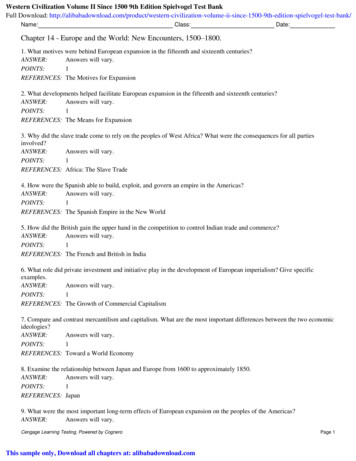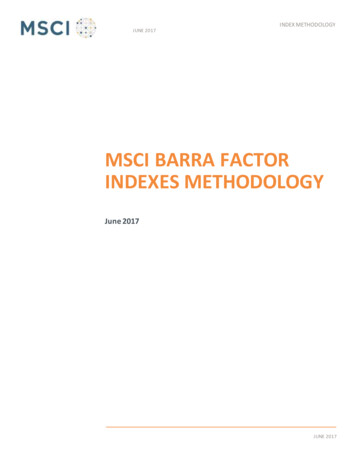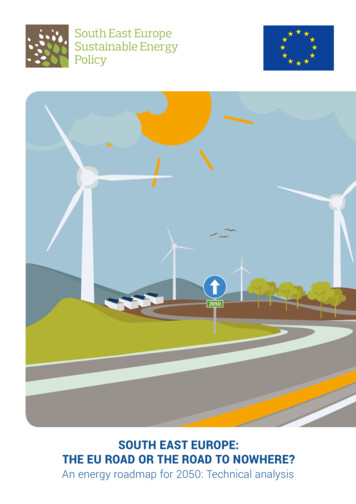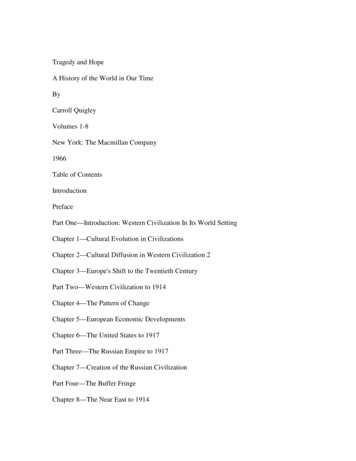
Transcription
Western Civilization Volume II Since 1500 9th Edition Spielvogel Test BankFull Download: test-bank/Name:Class:Date:Chapter 14 - Europe and the World: New Encounters, 1500–1800.1. What motives were behind European expansion in the fifteenth and sixteenth centuries?ANSWER:Answers will vary.POINTS:1REFERENCES: The Motives for Expansion2. What developments helped facilitate European expansion in the fifteenth and sixteenth centuries?ANSWER:Answers will vary.POINTS:1REFERENCES: The Means for Expansion3. Why did the slave trade come to rely on the peoples of West Africa? What were the consequences for all partiesinvolved?ANSWER:Answers will vary.POINTS:1REFERENCES: Africa: The Slave Trade4. How were the Spanish able to build, exploit, and govern an empire in the Americas?ANSWER:Answers will vary.POINTS:1REFERENCES: The Spanish Empire in the New World5. How did the British gain the upper hand in the competition to control Indian trade and commerce?ANSWER:Answers will vary.POINTS:1REFERENCES: The French and British in India6. What role did private investment and initiative play in the development of European imperialism? Give specificexamples.ANSWER:Answers will vary.POINTS:1REFERENCES: The Growth of Commercial Capitalism7. Compare and contrast mercantilism and capitalism. What are the most important differences between the two economicideologies?ANSWER:Answers will vary.POINTS:1REFERENCES: Toward a World Economy8. Examine the relationship between Japan and Europe from 1600 to approximately 1850.ANSWER:Answers will vary.POINTS:1REFERENCES: Japan9. What were the most important long-term effects of European expansion on the peoples of the Americas?ANSWER:Answers will vary.Cengage Learning Testing, Powered by CogneroThis sample only, Download all chapters at: alibabadownload.comPage 1
Name:Class:Date:Chapter 14 - Europe and the World: New Encounters, 1500–1800.POINTS:1REFERENCES: The Conquered10. How did the Columbia Exchange impact the Americas? What about Europe, Africa, and Asia?ANSWER:Answers will vary.POINTS:1REFERENCES: The Conquerors11. How did European expansion affect China? How did the Chinese view European efforts to control and expand trade?ANSWER:Answers will vary.POINTS:1REFERENCES: China12. What role did disease play in facilitating the Spanish conquest of the Aztecs and the Incas? In your opinion, wouldthese conquests have been possible without epidemics that swept through the Americas in the wake of Europeansettlement?ANSWER:Answers will vary.POINTS:1REFERENCES: The Spanish Empire in the New World13. Prester JohnANSWER:Answers will vary.POINTS:1REFERENCES: The Motives for Expansion14. The Travels of John MandevilleANSWER:Answers will vary.POINTS:1REFERENCES: The Motives for Expansion15. Marco PoloANSWER:Answers will vary.POINTS:1REFERENCES: The Motives for Expansion16. conquistadorsANSWER:Answers will vary.POINTS:1REFERENCES: The Spanish Empire in the New World17. “God, glory, and gold”ANSWER:Answers will vary.POINTS:1REFERENCES: The Means for ExpansionCengage Learning Testing, Powered by CogneroPage 2
Name:Class:Date:Chapter 14 - Europe and the World: New Encounters, 1500–1800.18. Ptolemy's GeographyANSWER:Answers will vary.POINTS:1REFERENCES: The Means for Expansion19. GoaANSWER:Answers will vary.POINTS:1REFERENCES: The Development of a Portuguese Maritime Empire20. compass and astrolabeANSWER:Answers will vary.POINTS:1REFERENCES: The Means for Expansion21. Prince Henry the NavigatorANSWER:Answers will vary.POINTS:1REFERENCES: The Development of a Portuguese Maritime Empire22. the Gold CoastANSWER:Answers will vary.POINTS:1REFERENCES: Africa: The Slave Trade23. Bartholomeu DiasANSWER:Answers will vary.POINTS:1REFERENCES: The Development of a Portuguese Maritime Empire24. Vasco da Gama and CalicutANSWER:Answers will vary.POINTS:1REFERENCES: The Means for Expansion25. Afonso de AlbuquerqueANSWER:Answers will vary.POINTS:1REFERENCES: The Development of a Portuguese Maritime Empire26. MalaccaANSWER:Answers will vary.POINTS:1REFERENCES: The Development of a Portuguese Maritime EmpireCengage Learning Testing, Powered by CogneroPage 3
Name:Class:Date:Chapter 14 - Europe and the World: New Encounters, 1500–1800.27. Spice IslandsANSWER:Answers will vary.POINTS:1REFERENCES: The Development of a Portuguese Maritime Empire28. Christopher ColumbusANSWER:Answers will vary.POINTS:1REFERENCES: Voyages to the New World29. John CabotANSWER:Answers will vary.POINTS:1REFERENCES: Voyages to the New World30. Amerigo VespucciANSWER:Answers will vary.POINTS:1REFERENCES: Voyages to the New World31. Ferdinand MagellanANSWER:Answers will vary.POINTS:1REFERENCES: Voyages to the New World32. Treaty of TordesillasANSWER:Answers will vary.POINTS:1REFERENCES: Voyages to the New World33. Hernán Cortés and MoctezumaANSWER:Answers will vary.POINTS:1REFERENCES: Spanish Conquest of the Aztec Empire34. the Aztecs and TenochtitlánANSWER:Answers will vary.POINTS:1REFERENCES: Spanish Conquest of the Aztec Empire35. the Inca and PachakutiANSWER:Answers will vary.POINTS:1REFERENCES: The Inca and the SpanishCengage Learning Testing, Powered by CogneroPage 4
Name:Class:Date:Chapter 14 - Europe and the World: New Encounters, 1500–1800.36. Francisco PizarroANSWER:Answers will vary.POINTS:1REFERENCES: The Inca and the Spanish37. encomiendaANSWER:Answers will vary.POINTS:1REFERENCES: Administration of the Spanish Empire38. viceroyANSWER:Answers will vary.POINTS:1REFERENCES: Administration of the Spanish Empire39. Society of FriendsANSWER:Answers will vary.POINTS:1REFERENCES: Effects of the Slave Trade40. Middle PassageANSWER:Answers will vary.POINTS:1REFERENCES: Growth of the Slave Trade41. triangular tradeANSWER:Answers will vary.POINTS:1REFERENCES: Growth of the Slave Trade42. "sugar factories"ANSWER:Answers will vary.POINTS:1REFERENCES: The West Indies43. Dutch East India CompanyANSWER:Answers will vary.POINTS:1REFERENCES: The West in Southeast Asia44. BataviaANSWER:Answers will vary.POINTS:1REFERENCES: The West in Southeast AsiaCengage Learning Testing, Powered by CogneroPage 5
Name:Class:Date:Chapter 14 - Europe and the World: New Encounters, 1500–1800.45. Mughal EmpireANSWER:Answers will vary.POINTS:1REFERENCES: The Mughal Empire46. British East India CompanyANSWER:Answers will vary.POINTS:1REFERENCES: The Impact of the Western Powers47. Robert CliveANSWER:Answers will vary.POINTS:1REFERENCES: The Impact of the Western Powers48. "Black Hole of Calcutta"ANSWER:Answers will vary.POINTS:1REFERENCES: The Impact of the Western Powers49. Ming and Qing dynastiesANSWER:Answers will vary.POINTS:1REFERENCES: China50. Lord Macartney and Emperor QianlongANSWER:Answers will vary.POINTS:1REFERENCES: China51. Tokugawa shogunsANSWER:Answers will vary.POINTS:1REFERENCES: Japan52. Nagasaki and the DutchANSWER:Answers will vary.POINTS:1REFERENCES: Japan53. Sor Juana Inés de la CruzANSWER:Answers will vary.POINTS:1REFERENCES: The ConqueredCengage Learning Testing, Powered by CogneroPage 6
Name:Class:Date:Chapter 14 - Europe and the World: New Encounters, 1500–1800.54. JesuitsANSWER:Answers will vary.POINTS:1REFERENCES: Spanish Missionaries55. price revolutionANSWER:Answers will vary.POINTS:1REFERENCES: Economic Conditions in the Sixteenth Century56. inflationANSWER:Answers will vary.POINTS:1REFERENCES: Economic Conditions in the Sixteenth Century57. joint stock companyANSWER:Answers will vary.POINTS:1REFERENCES: The Growth of Commercial Capitalism58. Amsterdam ExchangeANSWER:Answers will vary.POINTS:1REFERENCES: The Growth of Commercial Capitalism59. mercantilismANSWER:Answers will vary.POINTS:1REFERENCES: Mercantilism60. mestizos and mulattoesANSWER:Answers will vary.POINTS:1REFERENCES: The Conquered61. Columbian ExchangeANSWER:Answers will vary.POINTS:1REFERENCES: The Conquerors62. Gerardus MercatorANSWER:Answers will vary.POINTS:1REFERENCES: The ConquerorsCengage Learning Testing, Powered by CogneroPage 7
Name:Class:Date:Chapter 14 - Europe and the World: New Encounters, 1500–1800.63. Which event reopened the doors between Europe and east Asia in the thirteenth century?a. The Black Deathb. The Reformationc. The fall of the Ottomansd. Muslim conquestse. Mongol conquestsANSWER:ePOINTS:1REFERENCES: The Motives for Expansion64. Who was the Italian merchant whose tales of the court of Kublai Khan were popular in medieval Europe?a. Daniel Defoeb. Amerigo Vespuccic. Marco Polod. Leonardo Brunie. Jacques CourANSWER:cPOINTS:1REFERENCES: The Motives for Expansion65. Where was the kingdom of Prester John supposed to have been located?a. Africab. East Asiac. South Americad. North Americae. Southeast AsiaANSWER:aPOINTS:1REFERENCES: The Motives for Expansion66. Who produced a world map that was essential to European explorers in the late fifteenth century?a. Aristotleb. Prince Henry the Navigatorc. Ptolemyd. Christopher Columbuse. Hernán CortésANSWER:cPOINTS:1REFERENCES: The Means for Expansion67. Which Portuguese state leader initiated the European age of exploration?a. Vasco de Gamab. Prince Henry the NavigatorCengage Learning Testing, Powered by CogneroPage 8
Name:Class:Date:Chapter 14 - Europe and the World: New Encounters, 1500–1800.c. Bartholomeu Diasd. Francis Drakee. Amerigo VespucciANSWER:bPOINTS:1REFERENCES: The Development of a Portuguese Maritime Empire68. In the early fifteenth century, Portuguese fleets explored the western coast of Africa in search ofa. spices.b. gold.c. salt.d. tobacco.e. silk.ANSWER:bPOINTS:1REFERENCES: The Development of a Portuguese Maritime Empire69. Which sea captain made the first direct voyage from Europe to India?a. Bartholomeu Diasb. Ferdinand Magellanc. Francis Draked. Vasco da Gamae. Amerigo VespucciANSWER:dPOINTS:1REFERENCES: The Development of a Portuguese Maritime Empire70. What did Vasco da Gama hope to find in India?a. The fountain of youthb. Saltc. Slavesd. Precious stonese. SpicesANSWER:ePOINTS:1REFERENCES: The Development of a Portuguese Maritime Empire71. What best explains the success of the Portuguese in building a maritime empire?a. Guns and seamanshipb. Gold and faithc. Portugal’s growing populationd. Civil war in Chinae. Spanish helpCengage Learning Testing, Powered by CogneroPage 9
Name:Class:Date:Chapter 14 - Europe and the World: New Encounters, 1500–1800.ANSWER:aPOINTS:1REFERENCES: The Development of a Portuguese Maritime Empire72. What best exemplified early Spanish exploration of and expansion in the New World?a. The first circumnavigation of the globe by Amerigo Vespuccib. The conquest of the Aztec Empire by Cortésc. The conquest of the Incas by Magelland. Pizarro's landing at the Pacific coast of South America in 1530e. Da Gama's arrival in India in 1498ANSWER:bPOINTS:1REFERENCES: The Spanish Empire in the New World73. For which state did John Cabot, a Venetian, sail?a. Franceb. Venicec. Spaind. Portugale. EnglandANSWER:ePOINTS:1REFERENCES: Voyages to the New World74. Which explorer completed the first known circumnavigation of the earth?a. Amerigo Vespuccib. Ferdinand Magellanc. John Cabotd. Christopher Columbuse. Vasco da GamaANSWER:bPOINTS:1REFERENCES: Voyages to the New World75. What was the main provision of the Treaty of Tordesillas?a. It divided the Spice Islands between Portugal and the Dutch Republic.b. It divided South Africa between the English and the Dutch.c. It divided the New World between Spain and Portugal.d. It divided the North Atlantic between England and France.e. It divided the South Pacific between Spain and the Dutch Republic.ANSWER:cPOINTS:1REFERENCES: Voyages to the New WorldCengage Learning Testing, Powered by CogneroPage 10
Name:Class:Date:Chapter 14 - Europe and the World: New Encounters, 1500–1800.76. Mayan civilization came to include much ofa. modern-day Canada.b. the Pacific Coast of North America.c. the Mississippi Valley.d. Central America and southern Mexico.e. South America.ANSWER:dPOINTS:1REFERENCES: Early Civilizations in Mesoamerica77. Which major European disease caused high rates of mortality among the natives of the New World?a. Syphilisb. Yellow feverc. Smallpoxd. Scurvye. Avian fluANSWER:cPOINTS:1REFERENCES: Disease in the New World78. What was the encomienda?a. A Spanish system devised to collect tribute from natives and to use their laborb. A system of Spanish officials who supervised local industriesc. The taxes levied on the colonists by the Spanish governmentd. A hybrid tortilla made partly from maize and partly from wheat flowere. The mission schools set up to educate the IndiansANSWER:aPOINTS:1REFERENCES: Administration of the Spanish Empire79. When Moctezuma first encountered the Spanish, he believed they werea. Aztecs in disguise.b. foreign spies.c. representatives of a god.d. Mayans.e. punishment sent by the devil.ANSWER:cPOINTS:1REFERENCES: Spanish Conquest of the Aztec Empire80. Which conquistador conquered and looted the Inca Empire in 1531?a. CortezCengage Learning Testing, Powered by CogneroPage 11
Name:Class:Date:Chapter 14 - Europe and the World: New Encounters, 1500–1800.b. De Sotoc. Coronadod. De las Casase. PizarroANSWER:ePOINTS:1REFERENCES: The Inca and the Spanish81. By 1700, the population of central Mexico had fallen from 11 million in 1519 toa. 2.5 million.b. 6.5 millionc. 8 million.d. 500,000.e. 250,000.ANSWER:aPOINTS:1REFERENCES: Disease in the New World82. Most slaves taken to Portugal in the second half of the fifteenth century ended upa. in the galleys on the Portuguese navy.b. being re-exported to the Americas.c. working in copper mines.d. working on plantations.e. as domestic servants.ANSWER:ePOINTS:1REFERENCES: Africa: The Slave Trade83. Why were Native Americans not widely used as slaves on sugar plantations?a. The Church condemned slavery as immoral.b. They couldn't learn European languages.c. Their populations were too small due to European diseases.d. They were viewed as lazy and shiftless and refused to work.e. They fought back too well and too often to be profitable.ANSWER:cPOINTS:1REFERENCES: Africa: The Slave Trade84. How many Africans slaves were shipped to the New World between the sixteenth and the nineteenth centuries?a. One millionb. Two millionc. Five milliond. Ten millionCengage Learning Testing, Powered by CogneroPage 12
Name:Class:Date:Chapter 14 - Europe and the World: New Encounters, 1500–1800.e. Twenty-five millionANSWER:dPOINTS:1REFERENCES: Africa: The Slave Trade85. What statement best describes the impact of the African slave trade?a. It had little impact upon the number of wars in Africa.b. It reduced the number of wars in Africa because all the African states united against the European slavers.c. It increased the number of wars in Africa because of the increasing demand for prisoners who could be sold asslaves.d. It died out with the discovery of the South Asian Spice Islands.e. It was carried out peacefully as wars or violence would reduce the number of slaves and thus profits.ANSWER:cPOINTS:1REFERENCES: Africa: The Slave Trade86. In what part of Southeast Asia did the Spanish establish themselves?a. Siamb. The Philippinesc. Vietnamd. Javae. CambodiaANSWER:bPOINTS:1REFERENCES: The West in Southeast Asia87. Which European nation took over the spice trade from Portugal?a. Veniceb. Englandc. Spaind. Francee. The Dutch RepublicANSWER:ePOINTS:1REFERENCES: The West in Southeast Asia88. Why did the mainland states of Southeast Asia have better success in resisting European encroachment than did theSpice Islands and Malay states?a. They had greater natural resources desired by the Europeans.b. They were more politically cohesive with strong monarchies.c. Their existence was not known to the Europeans.d. They were Christians, and the Europeans never bothered their fellow Christians.e. They were allied to China, which gave them military support against the Europeans.Cengage Learning Testing, Powered by CogneroPage 13
Name:Class:Date:Chapter 14 - Europe and the World: New Encounters, 1500–1800.ANSWER:bPOINTS:1REFERENCES: The West in Southeast Asia89. The founders of the Mughal Empire came froma. the lush tropical forests of southern India.b. the foothills of the Urals in modern-day Russia.c. the mountainous region north of the Ganges River Valley.d. the islands groups near Sri Lanka.e. the Arab Middle East.ANSWER:cPOINTS:1REFERENCES: The Mughal Empire90. Which state was the major western rival to the British in India in the seventeenth century?a. Portugalb. Francec. Spaind. the Netherlandse. RussiaANSWER:bPOINTS:1REFERENCES: The Impact of the Western Powers91. Under pressure from the British, the French in India were eventually restricted to the fort ata. Calicut.b. Pondicherry.c. Delhi.d. Bombay.e. Hyderabad.ANSWER:bPOINTS:1REFERENCES: The Impact of the Western Powers92. Where was the local British population in India's Fort William imprisoned?a. "Bilious swamp of Madras"b. "Icy Ajanta caves"c. "Black Hole of Calcutta"d. "Red Fort of the Mughals"e. "Swampy sink of Purdah"ANSWER:cPOINTS:1REFERENCES: The Impact of the Western PowersCengage Learning Testing, Powered by CogneroPage 14
Name:Class:Date:Chapter 14 - Europe and the World: New Encounters, 1500–1800.93. Which European nation had the first direct contact with China since Marco Polo?a. Portugalb. Spainc. the Dutch Republicd. Russiae. EnglandANSWER:aPOINTS:1REFERENCES: The Development of a Portuguese Maritime EmpireNew Rivals on the World StageChina94. Which of these factors contributed to the decline of the Ming dynasty?a. Pressure by the Englishb. A series of weak rulersc. Pressure by the Dutchd. Religious strifee. Climate changeANSWER:bPOINTS:1REFERENCES: China95. Which Chinese dynasty replaced the Ming in the seventeenth century and came from Manchuria?a. Tangb. Songc. Yuand. Qine. QingANSWER:ePOINTS:1REFERENCES: China96. How did the Qing government respond to the arrival of European foreigners by sea?a. They opened China to diplomatic and trade opportunities with the Europeans.b. They established free trade connections, but no diplomatic relations.c. They engaged in trade, but confined European traders to a small island to limit contact.d. They refused all overtures to engage in trade.e. They allowed Europeans to have full contact and interaction with the Chinese.ANSWER:cPOINTS:1REFERENCES: Western Inroads97. Who were the first to be expelled from Japan by Tokugawa Ieyasu?Cengage Learning Testing, Powered by CogneroPage 15
Name:Class:Date:Chapter 14 - Europe and the World: New Encounters, 1500–1800.a. Catholic missionariesb. European merchantsc. European soldiersd. Protestant exilese. African slavesANSWER:aPOINTS:1REFERENCES: Opening to the West98. What was introduced into the Americas from Europe in the sixteenth century?a. Chocolateb. Dogsc. Potatoesd. Horsese. CornANSWER:dPOINTS:1REFERENCES: The Conquerors99. Where was the first permanent English settlement in North America located?a. Massachusetts Bayb. Plymouthc. New Yorkd. Jamestowne. QuebecANSWER:dPOINTS:1REFERENCES: British North America100. What was the long-term impact of the introduction of potatoes from the America to Europe?a. Inflation in Europeb. Population decrease in Europec. Population increase in Europed. Deflation in Europee. Epidemics in EuropeANSWER:cPOINTS:1REFERENCES: The Conquerors101. Who was most adversely affected by the price revolution?a. Land ownersb. Wage earnersc. MerchantsCengage Learning Testing, Powered by CogneroPage 16
Name:Class:Date:Chapter 14 - Europe and the World: New Encounters, 1500–1800.d. Clergye. SoldiersANSWER:bPOINTS:1REFERENCES: Economic Conditions in the Sixteenth Century102. What best describes the inflation of the sixteenth and early seventeenth centuries?a. It severely hampered commercial expansion.b. It caused a shift in industry to urban locales.c. It caused a decline in the standard of living for wage earners and those on fixed incomes.d. It was caused largely by a declining labor force.e. It was the result of too little money in circulation.ANSWER:cPOINTS:1REFERENCES: Economic Conditions in the Sixteenth Century103. Which statement applies to the economy of sixteenth- and seventeenth century Europe?a. The joint stock company enabled the raising of spectacular sums of capital for world trading ventures.b. The early seventeenth century saw a general stagnation in the areas of mining and metallurgy.c. Technological innovations improved the lives of peasants dramatically.d. The population explosion made for urban growth and more social equality in cities.e. An economic depression occurred because of a lack of specie.ANSWER:aPOINTS:1REFERENCES: The Growth of Commercial Capitalism104. Which city was the financial center of seventeenth-century Europe?a. Parisb. Londonc. Romed. Viennae. AmsterdamANSWER:ePOINTS:1REFERENCES: The Growth of Commercial Capitalism105. During the Middle Passage,a. gold and salt from Africa was shipped to Europe.b. slaves from Africa were shipped to the Americas.c. manufactured goods from Europe were shipped to Africa.d. agricultural commodities from the Americas were shipped to Europe.e. luxury goods from Asia were shipped to Europe.ANSWER:bCengage Learning Testing, Powered by CogneroPage 17
Name:Class:Date:Chapter 14 - Europe and the World: New Encounters, 1500–1800.POINTS:1REFERENCES: Africa: The Slave Trade106. According to mercantilists, a nation’s prosperity depended ona. maximizing imports.b. keeping taxes as low as possible.c. the elimination of restrictions on trade.d. a large supply of gold and silver.e. the size of its population.ANSWER:dPOINTS:1REFERENCES: Mercantilism107. Which statement best describes European trade and expansion by the end of the seventeenth century?a. International trade was much greater than intra-European trade.b. Wealth was being transferred back to the New World from Europe in the form of raw materials.c. Local, regional, and intra-European trade was considerably greater than international trade.d. Slavery was in decline in both Africa and the New World.e. European imperialism had come to an end.ANSWER:cPOINTS:1REFERENCES: Overseas Trade and Colonies: Movement Toward Globalization108. Which nation(s) or continent was least affected by European power and influence before the nineteenth century?a. China and Japanb. Africac. North Americad. South Americae. IndiaANSWER:aPOINTS:1REFERENCES: Chapter Summary109. In which area did an extensive multiracial society first appear?a. British North Americab. Latin Americac. Northern Europed. Southern Europee. ChinaANSWER:bPOINTS:1REFERENCES: The ConqueredCengage Learning Testing, Powered by CogneroPage 18
Name:Class:Date:Chapter 14 - Europe and the World: New Encounters, 1500–1800.110. Why did Catholic Christianity fail to take root in China in the seventeenth and eighteenth centuries?a. Opposition from Jesuit missionariesb. Opposition from Protestant missionariesc. Disagreement among religious orders and suppression by Chinese authoritiesd. Chinese anti-religious attitudese. Competition from Hindu missionariesANSWER:cPOINTS:1REFERENCES: Catholic Missionaries111. What was true of French North America?a. It was run autocratically.b. It was densely populated.c. It was a major exporter of grain to Europe.d. It was run as a republic.e. It benefitted from massive investments by the French crown.ANSWER:aPOINTS:1REFERENCES: French North America112. What was the West Indies’ most important export?a. Cottonb. Tobaccoc. Sugard. Golde. SaltANSWER:cPOINTS:1REFERENCES: The West Indies113. The primary motives for European expansion were “God, glory, and gold.”a. Trueb. FalseANSWER:TruePOINTS:1REFERENCES: The Motives for Expansion114. Portuguese ships in the Indian Ocean usually had no cannons.a. Trueb. FalseANSWER:FalsePOINTS:1REFERENCES: The Development of a Portuguese Maritime EmpireCengage Learning Testing, Powered by CogneroPage 19
Name:Class:Date:Chapter 14 - Europe and the World: New Encounters, 1500–1800.115. In 1492, knowledgeable Europeans knew that the world was round.a. Trueb. FalseANSWER:TruePOINTS:1REFERENCES: Voyages to the New World116. The decline of the Maya civilization was precipitated by the arrival of the Spanish.a. Trueb. FalseANSWER:FalsePOINTS:1REFERENCES: Early Civilizations in Mesoamerica117. The triangular trade linked Europe, Africa, and the Americas.a. Trueb. FalseANSWER:TruePOINTS:1REFERENCES: Growth in the Slave Trade118. The Dutch in Southeast Asia were supplanted by the Portuguese.a. Trueb. FalseANSWER:FalsePOINTS:1REFERENCES: The West in Southeast Asia119. By the middle of the seventeenth century, China was in steep decline.a. Trueb. FalseANSWER:FalsePOINTS:1REFERENCES: China120. After unifying Japan, Tokugawa Ieyasu took the title of shogun.a. Trueb. FalseANSWER:TruePOINTS:1REFERENCES: Japan121. By 1750, the population of British North America had reached about 1.5 million.Cengage Learning Testing, Powered by CogneroPage 20
Western Civilization Volume II Since 1500 9th Edition Spielvogel Test BankFull Download: test-bank/Name:Class:Date:Chapter 14 - Europe and the World: New Encounters, 1500–1800.a. Trueb. FalseANSWER:TruePOINTS:1REFERENCES: British North America122. Mercantilist policy makers sought to establish a favorable balance of trade.a. Trueb. FalseANSWER:TruePOINTS:1REFERENCES: MercantilismCengage Learning Testing, Powered by CogneroThis sample only, Download all chapters at: alibabadownload.comPage 21
Chapter 14 - Europe and the World: New Encounters, 1500–1800. Cengage Learning Testing, Powered by Cognero Page 9 c. Bartholomeu Dias d. Francis Drake e. Amerigo Vespucci ANSWER: b POINTS: 1 REFERENCES: The Development of a Portuguese Maritime Empire 68. In the early fifteenth century, Portuguese fleets exp











